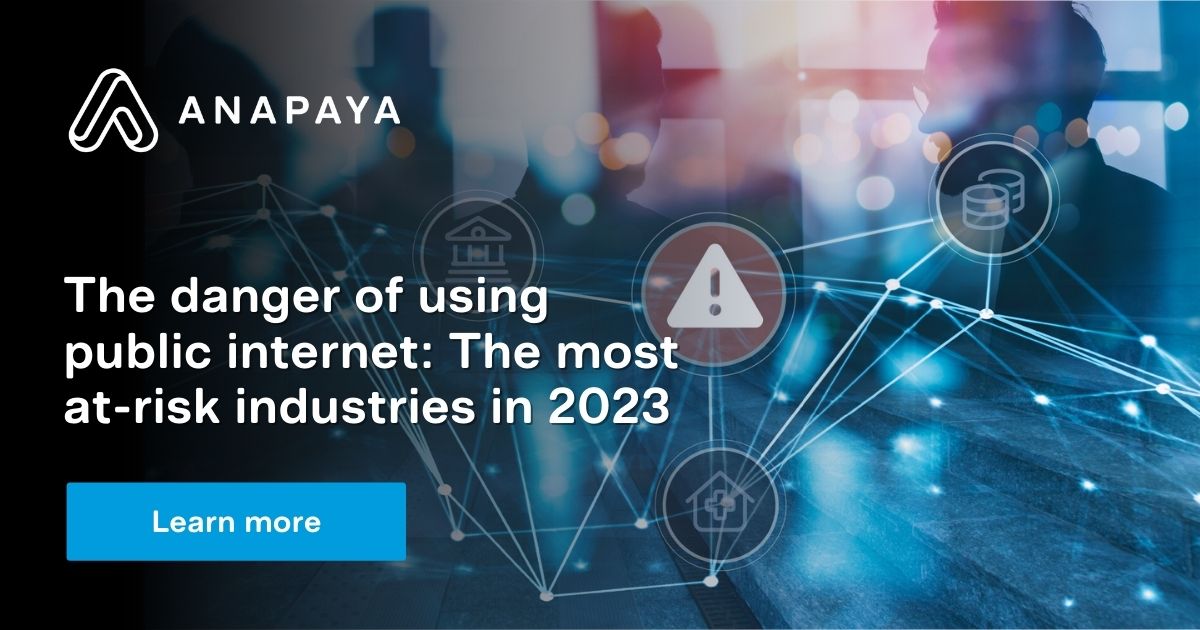Last year was a tumultuous year for cybersecurity across the globe. After COVID-19 exposed already-strained healthcare and public sectors to unprecedented levels of virtual attacks, an increase in cashless transactions and working from home provided a fertile hunting ground for hackers.
But as conflict broke out in Ukraine, this new normal was shattered by an uptick in digital warfare used to subvert and attack opposing forces. No longer the sole concern of massive corporations, cybersecurity is now a matter of personal and professional security.
Here at Anapaya, we know that it’s never all bad news. With ever-evolving shifts in cybercrime come opportunities to make the public internet safer and more resilient. Past events have shown that some industries are more attractive to cyber attackers with particular motives, be they financial, political or other. With this in mind, this blog presents our predictions for the industries most at risk of cybercrime in 2023.
Healthcare
As hospitals and medical services store vast amounts of patient information, they will continue to make ideal targets for cybercriminals in 2023.
Electronic healthcare records contain a bevy of personal information, financial details, and medical histories. For this reason, they are frequently attacked by cybercriminals seeking to misuse or steal data. Recently, cybercriminals had taken advantage of the chaos surrounding COVID-19 and repeatedly shut down hospitals’ networks at a time when they were least able to respond.
A 2020 ransomware attack forced a hospital in Düsseldorf, Germany, to close its emergency department, resulting in the death of a patient as they had to be rerouted to another hospital. In October 2022, another attack immobilized medical software, resulting in a 3-year-old boy being given five times the pain medication than prescribed (luckily, he survived).
A 2021 study from the Ponemon Institute surveyed more than 600 healthcare facilities and found that mortality rates increased at a quarter of the facilities following a ransomware attack. Yet, a recent report by CyberMDX and Philips revealed that only 11% of respondents in the healthcare sector regard cybersecurity as a high-priority spend.
Cybersecurity is one of the biggest threats to healthcare. In 2023, these organizations need to have their networks and systems locked down to facilitate HIPAA compliance and protect electronic health information.
Government and public services
2022 was a year of significant cyber incidents targeting governments to disrupt public services. In November, it was revealed that the UAE had hired three former U.S. intelligence and military officials to help the government break into computers in the United States and other countries. In late September, a campaign from a Russian GRU hacking group aimed cyberattacks at transportation and related logistics industries in Ukraine and Poland.
The government sector has experienced particularly significant growth in staff working from home since the pandemic. This is partly due to the increasing digitalization of government services, coupled with the affordability and omnipresence of personal technology, making it possible for remote workers to be just as efficient and productive as inside the office.
However, devices such as phones or laptops rely on a connection to the public internet, significantly increasing the attack surface available to hackers.
In 2022, “hacktivist” activity — hacking for political purposes — accounted for about 9% of recorded incidents as attacks on the government sector rose by over 95% in the last half of 2022. India, the US, Indonesia, and China continued to be the most targeted countries in the past two years, accounting for 40% of total reported incidents.
Government and public services hold a massive amount of information on private citizens, which may be sold on the dark web or used for terrorist purposes. To keep data safe, governments must adopt cutting-edge security infrastructure and only permit remote working on approved, secure devices provided by the company.
Finance
With the expansion of digital banking services and decentralized finance technology, the financial sector is undergoing an exciting renaissance that promises to transform how people manage their money. Unfortunately, this creates more opportunities for hackers to target financial institutions and the customers who rely on them.
One recent survey from IBM found that 85% of companies operate in multiple public and private clouds, with financial institutions routinely moving network traffic over the public internet. Thus, finance is one of the industries most at risk from a cyber attack.
In April 2022, finance platform Beanstalk Farms lost $180 million in a cryptocurrency heist. Earlier in March, credit bureau TransUnion SA suffered a cyber attack which saw around three million customers' data stolen by international hackers.
In a new survey commissioned by Yooz, 44% of UK finance leaders said their department is planning to emphasize their efforts regarding cybersecurity over the next 12 months. This reflects the increasing priority the finance sector is placing on innovation: with new technology come expanded attack surfaces and more opportunities for hackers to strike. Focus has to be placed on securing digital operations with flexible, functional networking software that will shield transactions and customers’ vulnerable information from cyberattacks.
Protect against cyberattacks in 2023
Securing your most valuable asset – data – should be the top priority in any industry. Research has shown us that cyberattacks are on the rise and no longer only targeting large organizations. Smaller companies are just as much at risk, and whether or not they belong to the industries listed above, they are at risk if they hold data or conduct business online.
Investing in cybersecurity is the best way to protect your business, employees and customers in 2023, and you can do it all with SCION. Offered by Anapaya, SCION is a world-class security solution for organizations that want the best in network protection.
Enable SCION today. Contact us to arrange a safer future for you and your organization.
TAGS:
SCION, Finance, Healthcare, Government









